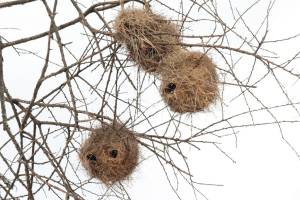Table of Contents
Group 9
<html><font size=6 face=“Arial”>Egg tossing</font></html>
Wiki site of the practical exercise of the IX Southern-Summer School on Mathematical Biology.
Here you will find the exercise assignment and the group's products.
If you are a group member login to edit this page, create new pages from it, and upload files.
Introduction
The gray-capped social weaver (Pseudonigrita arnaudi) is a cooperatively breeding bird species, that is, members of that species may help to raise offspring of neighboring nests, from the clutch formation, to hatching and feeding the newborns.
Some members of this species may toss eggs in adverse situations, such as to make space for new eggs when a nest is full or when the egg is unfertilized. Recently, a new event was discovered to trigger egg toss: when predation levels are high and clutch size becomes too small, some gray-capped social weaver parents may toss their eggs as a strategy to maximize its reproductive success, which is alleged to be a new feature in social birds, and is called parental tossing.
The hypothesis is that the investment in hatching and nurturing the remaining eggs and newborns of the reduced clutch has a high risk of no return, since these newborns may die before hatching or maturing.
 Therefore, the gray-capped social weavers would throw these eggs out and save the energy and resources to the next breed, in which the probability of success is higher, since the new breed would have a higher number of eggs. Another hypothesis is that, through tossing their eggs, birds are actually removing the main resources of their eggs' predators, keeping its populational sizes under control and possibly enhancing the survival probability of the future clutch.
Therefore, the gray-capped social weavers would throw these eggs out and save the energy and resources to the next breed, in which the probability of success is higher, since the new breed would have a higher number of eggs. Another hypothesis is that, through tossing their eggs, birds are actually removing the main resources of their eggs' predators, keeping its populational sizes under control and possibly enhancing the survival probability of the future clutch.
Assignment
Propose a mathematical model for the population dynamics of the gray-capped social weavers with tossing and non-tossing strategies.
Suggested questions
- What would be the demographic consequences of the egg-tossing behaviour by parents? Can you derive measures of the success of the egg-tossing strategy from these consequences? What scenarios favor the strategy?
- What species' traits affect the strategy reward and how do they influence it? For example, the reward may be affected by amount of predation risk of the remaining eggs, or by the threshold number of remaining eggs before parental decision to perform the tossing.
- Does the success of tossing depend on the size of the weaver and predator populations? Why and how?
Further well-grounded questions from the group are welcome.
References
Cheng, Y. R., Rubenstein, D. R., & Shen, S. F. Nest predation predicts infanticide in a cooperatively breeding bird. Biology Letters, 2019 https://royalsocietypublishing.org/doi/pdf/10.1098/rsbl.2019.0314
